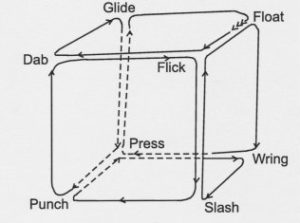The “dynamosphere” is a three-dimensional model of effort relationships. Laban chose a cube for depicting effort kinships. Cate Deicher and I will be exploring these relationships in the forthcoming workshop, “Expanding the Dynamosphere.

Many people are familiar with the way Laban positioned the eight basic actions (floating, gliding, pressing, punching, etc.) at each of the eight corners of the cube. Whimsically, Laban likened this effort model to a “town with a good many cross-roads and squares between houses in which the effort microbes live.” He goes on to add, “It is a curious peculiarity of this city that near relatives dwell nearer to each other than more distant relatives, and these live nearer than strangers or enemies. Hostile effort microbes, who have no effort constituents in common, live at diametrically opposite sides of the city.”
Laban’s dynamospheric action map depicts these relationships. But effort theory goes well beyond the eight basic actions, to incorporate the three transformative Drives (Passion, Vision, and Spell), as well as six “incomplete actions” or effort states (Dream, Awake, Near, Remote, Stable and Mobile) and the four elemental motion factors (Weight, Time, Space, and Flow). Laban also used a different cubic model to depict kinship relations among all these elements and effort combinations.
This little-known cubic model not only summarizes Laban’s whole effort theory, it also maps organic transitions between effort moods. It is a wonderful resource for building effort phrases. Find out more in the forthcoming Red Thread workshop.
